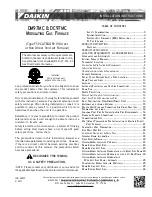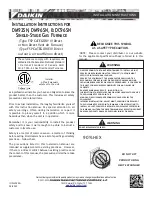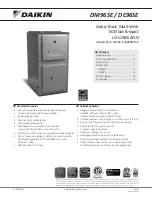
39
I
NDUCED
D
RAFT
AND
C
IRCULATOR
B
LOWERS
The bearings in the induced draft blower and circulator blower
motors are permanently lubricated by the manufacturer. No fur-
ther lubrication is required. Check motor windings for accumu-
lation of dust which may cause overheating. Clean as neces-
sary.
F
LAME
S
ENSOR
(Q
UALIFIED
S
ERVICER
O
NLY
)
Under some conditions, the fuel or air supply can create a
nearly invisible coating on the flame sensor. This coating acts
as an insulator causing a drop in the flame sense signal. If the
flame sense signal drops too low the furnace will not sense
flame and will lock out. The flame sensor should be carefully
cleaned by a qualified servicer using emery cloth or steel wool.
Following cleaning, the flame sense signal should be as indi-
cated in the Specifications Sheet.
F
LUE
P
ASSAGES
(Q
UALIFIED
S
ERVICER
O
NLY
)
The heat exchanger flue passageways should be inspected at
the beginning of each heating season. If necessary, clean the
passageways as outlined in the following steps.
1. Turn OFF the electrical power and gas supply to the
furnace.
2. Disconnect the gas line and remove the burner/ manifold
assembly by removing the screws securing the assembly
to the partition panel.
3. Disconnect the flue pipe system from the induced draft
blower.
4. Remove the induced draft blower and collector box cover.
5. Clean the primary heat exchanger tubes using a wire
brush attached to a length of high grade stainless steel
cable, such as drain cleanout cable. Attach a variable
speed reversible drill to the other end of the cable. Slowly
rotate the cable with the drill and insert it into one of the
heat exchanger tubes. While reversing the drill, work
the cable in and out several times to obtain sufficient
cleaning. Repeat for each tube.
6. Clean residue from furnace using a vacuum cleaner.
7. Replace the parts removed in the previous steps in
reverse order.
8. Turn on electrical power and gas to furnace. Check for
leaks and proper unit operation.
9. Severe heat exchanger fouling is an indication of an
operational problem. Perform the checks listed in
Startup Procedure and Adjustments
to reduce the
chances of repeated fouling.
B
EFORE
L
EAVING
AN
I
NSTALLATION
•
Cycle the furnace with the thermostat at least three
times. Verify cooling and fan only operation.
•
Review the Owner’s Manual with the homeowner and
discuss proper furnace operation and maintenance.
•
Leave literature packet near furnace.
R
EPAIR
AND
R
EPLACEMENT
P
ARTS
•
When ordering any of the listed functional parts, be sure
to provide the furnace model, manufacturing, and serial
numbers with the order.
•
Although only functional parts are shown in the parts
list, all sheet metal parts, doors, etc. may be ordered by
description.
•
Parts are available from your distributor.
Functional Parts List-
Gas Valve
Blower Motor
Gas Manifold
Blower Wheel
Natural Gas Orifice
Blower Mounting Bracket
Propane Gas Orifice
Blower Cutoff
Igniter
Blower Housing
Flame Sensor
Inductor
Rollout Limit Switch
Heat Exchanger
Primary Limit Switch
Auxiliary Limit Switch
Pressure Switch
Integrated Control Module
Induced Draft Blower
Transformer
Door Switch










































